#jacopo da sellaio
Text

Jacopo da Sellaio - Triumph of Time. Detail. 1485 - 1490
67 notes
·
View notes
Text
went to wawel castle to pay a visit, i look at the interiors, paintings, all is cool and nice. and then i enter a room and by god by golly there's my guy my best friend my dude Orpheus himself hanging at the wall! THE ORIGINAL! the 15th century original of the painting i had to copy as part of my training in 2015

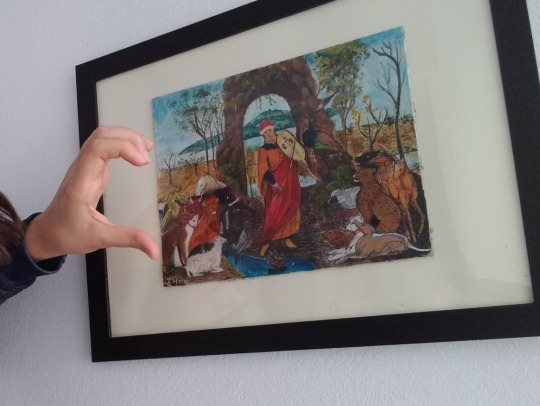
bestie, yer evil clone is on my wall forever
#Jacopo da Sellaio#Orpheus playing among the animals#evil clone homemade by yours truly#greek mythology#wawel castle#orpheus#face cw
7 notes
·
View notes
Text

Jacopo da Sellaio
3 notes
·
View notes
Text
Tнe Sтory oғ Cυpιd αɴd Pѕycнe вy Jαcopo del Sellαιo (1442 ~ 1493)

Jacopo del Sellaio (1442 - 1493)
Cupid and Psyche, c.1473
Tempera and gold on a wooden panel
Fitzwilliam Museum, Cambridge UK.
𝐖𝐡𝐨 𝐩𝐚𝐢𝐧𝐭𝐞𝐝 𝐢𝐭?
Jacopo da Sellaio (c. 1441 - 1493), sometimes known as Jacopo di Arcangel, was an eclectic Italian painter from the early Renaissance, who painted in the style of the Florentine School. His style of painting uses a light palette of colours and experiments with linear perspective. He was a pupil of Fra' Filippo Lippi, with his contemporary Sandro Botticelli, who became a lasting influence on him. It is noted that by 1460, he had joined the Confraternity of Saint Luke (Compagnia di S Luca) in Florence, and in 1473, he is documented to have shared a studio with Filippo di Giuliano.

𝐖𝐡𝐲 𝐰𝐚𝐬 𝐢𝐭 𝐦𝐚𝐝𝐞?
This colorful panel is from a 'spalliera', a decorated backboard. It would either be mounted on a wall as a headboard or attached to furniture, most commonly a ‘cassone’ (marriage chest). These special chests were made to celebrate a marriage, and were part of a bride’s dowry. They were filled with expensive linen and cloths and paraded through the streets from the bride’s family home to her new home as part of the wedding celebration. It would then be used as a piece of furniture in the family home for storage and sometimes as a bench to sit on.
Giorgio Vasari, 1550, recalling cassoni painting of the previous century:
'𝐄𝐯𝐞𝐧 𝐭𝐡𝐞 𝐦𝐨𝐬𝐭 𝐞𝐱𝐜𝐞𝐥𝐥𝐞𝐧𝐭 𝐩𝐚𝐢𝐧𝐭𝐞𝐫𝐬 𝐞𝐱𝐞𝐫𝐜𝐢𝐬𝐞𝐝 𝐭𝐡𝐞𝐦𝐬𝐞𝐥𝐯𝐞𝐬 𝐢𝐧 𝐬𝐮𝐜𝐡 𝐥𝐚𝐛𝐨𝐫𝐬,
𝐰𝐢𝐭𝐡𝐨𝐮𝐭 𝐛𝐞𝐢𝐧𝐠 𝐚𝐬𝐡𝐚𝐦𝐞𝐝, 𝐚𝐬 𝐦𝐚𝐧𝐲 𝐰𝐨𝐮𝐥𝐝 𝐛𝐞 𝐭𝐨𝐝𝐚𝐲, 𝐭𝐨 𝐩𝐚𝐢𝐧𝐭 𝐚𝐧𝐝 𝐠𝐢𝐥𝐝 𝐬𝐮𝐜𝐡 𝐜𝐡𝐞𝐬𝐭𝐬.'
𝐖𝐡𝐚𝐭 𝐢𝐬 𝐡𝐚𝐩𝐩𝐞𝐧𝐢𝐧𝐠 𝐢𝐧 𝐭𝐡𝐞 𝐩𝐢𝐜𝐭𝐮𝐫𝐞?
Cupid and Psyche is a story originally from Metamorphoses, written in the 2nd century AD by Lucius Apuleius Madaurensis. The tale concerns the overcoming of obstacles to the love between Psyche and Cupid or Eros, and their ultimate union in a sacred marriage.
The panel shows the first half of this ancient romance in which the mortal princess Psyche is married to the god of love, Cupid. The story is read from left to right like a cartoon strip. Two bedchambers ‘bookend’ the action at either end- on the left Psyche is conceived and born, and the room on the right hand side shows her marital bed with Cupid. Sellaio arranges everything symmetrically to balance out the different elements of the picture. For instance, the hovering figure of Cupid is echoed by the figure of Psyche being blown from her mountain, and the three suitors match the sisters on the other side of the composition.
Fifteen episodes from the story appear across the panel. Many of these involve the same characters and all take place against a simple background and landscape. Psyche appears twelve times ~ eleven as a women and once as a baby. This method of visual storytelling is called ‘continuous narrative’ and is inspired by classical models such as Roman sarcophagi. This might be confusing today when we are used to seeing single frames of action.
However, this was a familiar way of telling stories in Renaissance Italy. So the story is read from left to right like a cartoon strip.
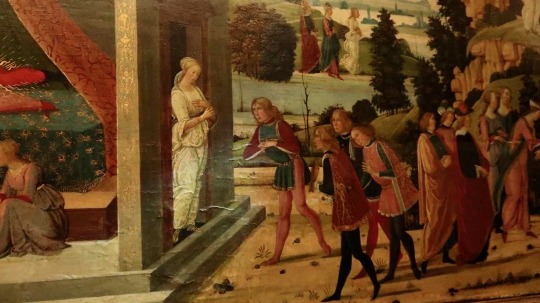
~Young Psyche with her courtiers when Cupid first sets eyes on her~

~Cupid sets eyes of Psyche and cannot follow through his mother, Venus's, evil plan~
~Cupid falls in love with Psyche and is unable to carry out Venus’ evil plan~

~Psyche is blown off the hill by Zephyrus the wind~
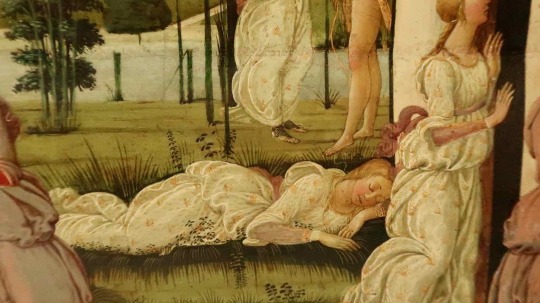
~Psyche lands on a soft bower~
When she awakes, she finds herself at a beautiful palace where she is welcomed by an invisible, but kind, master (Cupid, in hiding from his mother). He invites Psyche to live with him on the condition that she will never ask his true identity. They are happy for a while but then Psyche’s sisters persuade her to look at him whilst he sleeps. A drop of oil lands on his skin, he wakes up and is angered by Psyche’s lack of trust.

~Psyche lifting Cupid's wing~
The story continues in a second panel (in a private collection). Cupid returns to his mother, Psyche searches for him and is captured and enslaved by Venus. Cupid pleads with Jupiter, king of the gods, to free Psyche. He agrees, and Cupid and Psyche are married.

~Story of Psyche ~ second panel,
Jacopo da Sellaio (1441/1442–1493)
c. 1490
Museum of Fine Arts Boston.

(detail from the second panel)
#the story of cupid and psyche#eros and psyche#renaissance#history of art#jacopo da sellaio#Sandro Botticelli#giorgio vasari#painting#artwork#art of the day
41 notes
·
View notes
Photo


Jacopo da Sellaio - Orpheus, Eurydice and Aristaeus (1475-80) .
0 notes
Photo


Simonetta Vespucci (1453 - 1476)

Portrait of a Young Woman is believed to be Sandro Botticelli‘s, executed between 1480 and 1485. Others attribute authorship to Jacopo da Sellaio. The cameo she wears is a copy in reverse of "Nero's Seal", a famous antique carnelian representing Apollo and Marsyas, which belonged to Lorenzo de' Medici.
The art historian Aby Warburg first suggested the painting was an idealised portrait of Simonetta Vespucci (birth of Venus)
thnx fishstickmonkey & helenart555
#Sandro Botticelli#Botticelli#Renaissance#portrait#iconic#profile#Simonetta Vespucci#model#Medici#beauty#masterpiece#nose#Florence#lips
24 notes
·
View notes
Text

Idealised Portrait of a Lady (Portrait of Simonetta Vespucci as Nymph) is a painting which is commonly believed to be by the Italian Renaissance painter Sandro Botticelli, executed between 1480 and 1485. Others attribute authorship to Jacopo da Sellaio. (Städel Museum, Frankfurt)
25 notes
·
View notes
Text

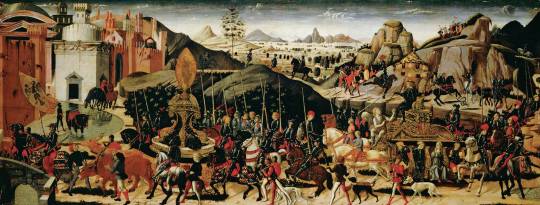

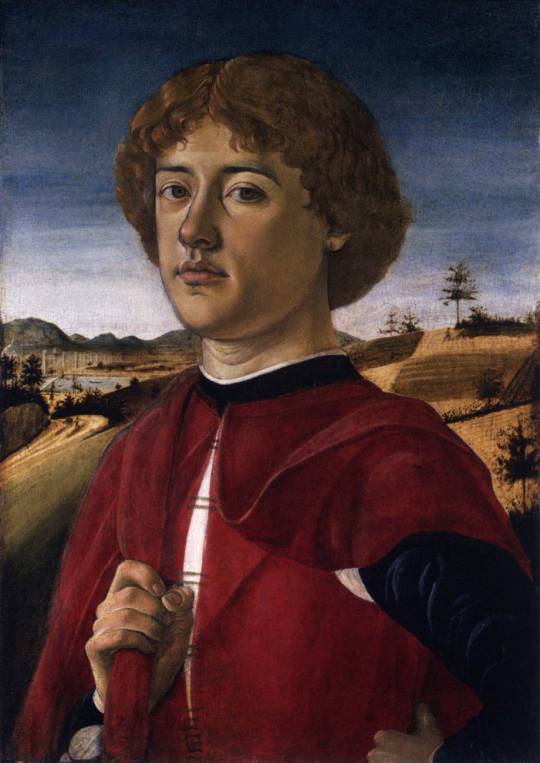

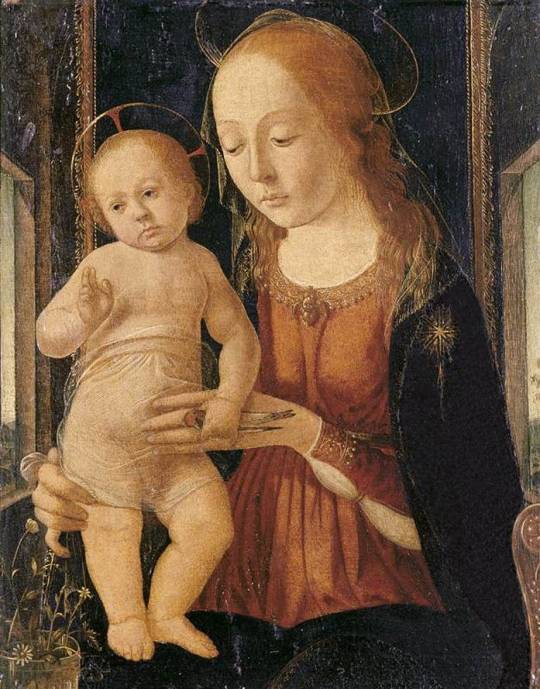



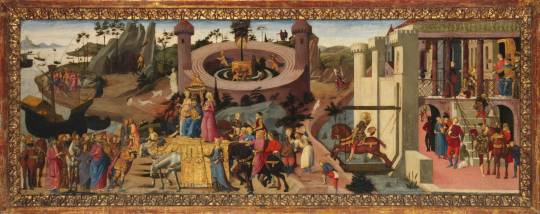

By: Amy Fredrickson
On this day in 1516, Florentine painter Biagio d'Antonio dei Tucci died. He was a prolific artist who was successful both in his native Florence and in other places in Italy; yet, he is often omitted from literature. His works were often confused with, and credited to more renowned artists like Perugino, Botticelli, and Ghirlandaio. Like Biagio, these artists also worked in Rome and decorated the Sistine Chapel during the 1480s. A similar instance occurred with commissions in Faenza, where Biagio was confused with the painters Andrea Utili and Giovanni Battista Utili who, coincidently, also resided in the town and painted cassoni.
As a result, scholars know little about Biagio’s early training. His style exhibits Florentine’s innovations of the late fifteenth-century, such as Fra Fillipo Lippi’s linear style of modeling, Verrocchio’s sculptural influence, and the integration of Netherlandish coloring. Biagio’s connection to Verrocchio is unknown, yet it is confirmed that he collaborated with the painter Cosimo Rosselli in 1470. At this point though, he was a fully trained artist.
Biagio specialized in works for domestic interiors, such as religious panel paintings featuring the Madonna and Child and decorative wedding chests exhibiting biblical and mythological scenes. Biagio favored rich colors that illuminated his subject matter. By 1472, he shared a workshop with Jacopo del Sellaio, with whom he collaborated on cassoni commissions. He established a large studio in Faenza by 1476, which he maintained for about thirty years.
While he was based in Faenza, Biagio traveled to various Italian cities to assist other artists on large commissions. For example, he aided Pietro Perugino with paintings in the Palazzo della Signoria. Then, between 1481 and 1482, he worked with Cosimo Rosselli on frescoes in the Sistine Chapel. Their works included The Last Supper and most likely The Crossing of the Red Sea.
Documents prove that he was still active in 1504 when he painted an altarpiece for the widow of Vincenzo Bazzolini depicting the Madonna and Child with Saints John the Evangelist and Anthony of Padua for the church of San Francesco in Faenza. After 1504, it is unknown whether he had other commissions or if he returned to Florence. Biagio d'Antonio dei Tucci died on June 1, 1516.
References:
"BIAGIO D'antonio Da Firenze In "Dizionario Biografico"". 2019. Treccani.It. http://www.treccani.it/enciclopedia/biagio-d-antonio-da-firenze_(Dizionario-Biografico)/.
Boskovits, Miklós, and David Alan Brown, et al, Italian Paintings of the Fifteenth Century. The Systematic Catalogue of the National Gallery of Art. (Washington, D.C., 2003).
Further Reading:
Bartoli, Roberta, Biagio d'Antonio, (Milan, 1999).
Images:
Virgin and Child Enthroned with Five Saints and Two Angels, 1470-75, Tempera on panel, 168 x 178 cm, Szépművészeti Múzeum, Budapest.
The Triumph of Camillus, 1470-75, Tempera on panel, 60 x 154 cm,
National Gallery of Art, Washington.
Scenes from the Story of Io, 1480s, Tempera on poplar panel, 74 x 133 cm, Private collection.
Portrait of a Young Man, c. 1470, Tempera on wood, 54 x 39 cm, Metropolitan Museum of Art, New York.
Portrait of a Boy, 1476-80, Oil and tempera on panel, 42 x 36 cm, National Gallery of Art, Washington.
Madonna and Child, 1490s, Oil on panel, 45 x 38 cm
Private collection.
Madonna Adoring the Child with an Angel, c. 1475, Tempera on panel, 74 x 54 cm, Museu de Arte, São Paulo.
Crucifixion, 1482, Fresco, Cappella Sistina, Vatican.
Arrest of Christ, 1482, Fresco, Cappella Sistina, Vatican.
Scenes from the Story of the Argonauts, c. 1465, Tempera on wood, gilt ornaments, 50 x 142 cm, Metropolitan Museum of Art, New York.
Chest and spalliera with the arms of Lorenzo Morelli and Vaggia Nerli (The Morelli Chest), 1472, Tempera on panel, The Courtauld Institute of Art, London.
#Italian Renaissance#Florence#Faenza#Rome#fifteenth century#andrea del verrocchio#Pietro Perugino#painting#wall painting#Fresco#biagio d'antonio tucci#Sistine Chapel
30 notes
·
View notes
Photo

Saint Jerome in the Wilderness
Jacopo da Sellaio, c. 1470-1490
103 notes
·
View notes
Photo


Scenes from the Story of the Argonauts Biagio d'Antonio and Jacopo da Sellaio, c. 1465
#biagio d antonio#jacopo da sellaio#1460s#15th century#mdp15th c.#italian renaissance#italy#15th c. Italy#mythology
39 notes
·
View notes
Text

Jacopo da Sellaio - Triumph of Time. 1485 - 1490
33 notes
·
View notes
Text

Jacopo da Sellaio - Triumph of Time. Detail. 1485 - 1490
14 notes
·
View notes
Text

Jacopo da Sellaio - Triumph of Time. Detail. 1485 - 1490
34 notes
·
View notes
Photo

Jacopo da Sellaio - Orpheus Playing Among the Animals. 1480 - 1490
#art#renaissance#jacopo da sellaio#mythology#orpheus#playing#musician#animals#landscape#the landscape#spalliera#dragon
66 notes
·
View notes
Photo

Jacopo da Sellaio (1441 - 1493) - Virgin and Child.
29 notes
·
View notes
Photo

Jacopo da Sellaio - Esther before Ahasuerus. 1470
33 notes
·
View notes